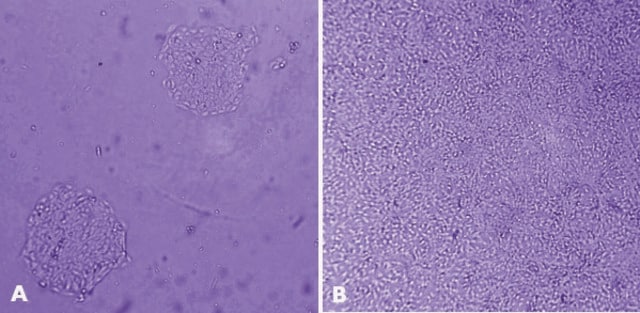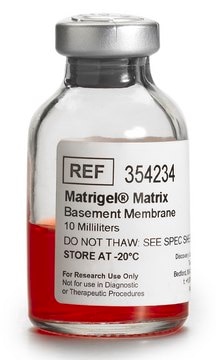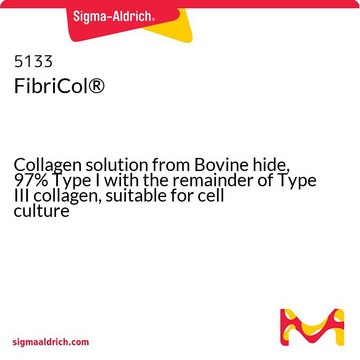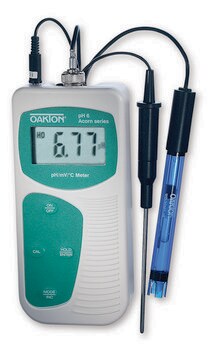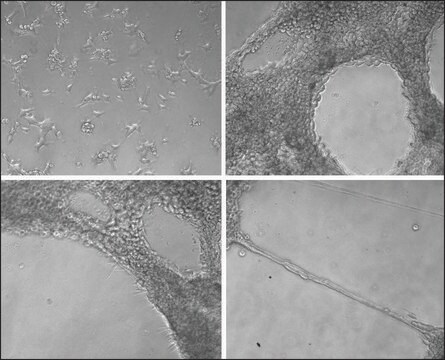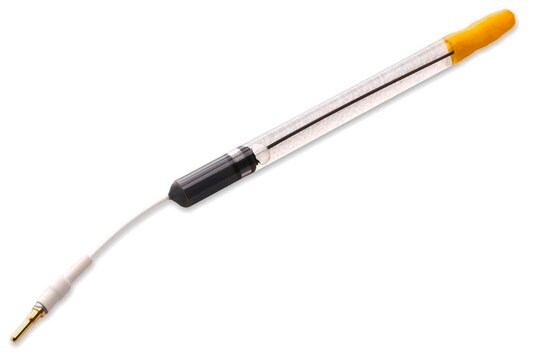推荐产品
一般說明
PureCol™用于细胞培养、组织工程和作为医疗器械的包被材料。PureCol EZ凝胶是一种即用型胶原蛋白溶液,只需在培养箱中加热到37°C即可形成牢固的凝胶。本品由纯化的I型牛胶原(浓度约为5 mg/mL (0.5%))、DMEM/F-12培养基、L-谷氨酰胺和二肽(L-丙氨酸-L-谷氨酰胺)混合物组成,为细胞培养提供持久的L-谷氨酰胺来源。
應用
PureCol™ EZ凝胶溶液用于:
- 包被培养板,促进人鼻上皮组织来源上皮细胞的接种和生长
- 作为生物人工肌腱成分,提供促进人肌腱细胞接种生长和胶原凝胶形成的凝胶基质
- 包埋三维胶原构建体中的小鼠跟腱来源细胞,提供用于肌腱生物学研究的仿生环境和进行qPCR、免疫组合和蛋白质免疫分析。
特點和優勢
PureCol EZ Gel 旨在通过提供已经调节至中性 pH 值的培养基和胶原预配制溶液来提高凝胶的粘稠度,该产品通过试剂添加变量 pH 值调节和处理条件等变量避免了凝胶制备过程中出现的不一致性。PureCol EZ Gel 是提供牢固凝胶的理想选择,也可用于制备培养细胞的薄层。PureCol EZ Gel 胶原蛋白包装方便用户使用和储存。本产品为无菌产品,现成溶液供应。PureCol EZ Gel 的可用体积为 35 mL,通过无菌工艺生产。3D 凝胶允许研究 ECM 的力学属性,如密度和硬度,对细胞发育、迁移和形态的影响。与 2D 系统不同,3D 环境允许细胞延伸同时与所有细胞表面的整合素相互作用,从而激活特定的信号通路。在 3D 和 2D 环境中,凝胶硬度或硬度对细胞迁移的影响也不同。此外,整合蛋白独立的机械相互作用导致的缠结的基质原纤维与细胞扩展可能在三维系统中,但不是在二维系统中,后者情况下,细胞附着在一个平面。1-3
準備報告
3-D 凝胶制备程序
1. 从 2-10°C 储存条件下取出 PureCol EZ Gel。为防止凝胶化,将产品温度维持在 2-10℃。
2. 将 PureCol EZ Gel 引入细胞培养系统。细胞可以加入到 PureCol EZ Gel 溶液中。
3. 要形成凝胶,加温至 37°C。凝胶化开始将在 40 min 内发生,但需要约 90 min 至 分钟以形成牢固的凝胶。
1. 从 2-10°C 储存条件下取出 PureCol EZ Gel。为防止凝胶化,将产品温度维持在 2-10℃。
2. 将 PureCol EZ Gel 引入细胞培养系统。细胞可以加入到 PureCol EZ Gel 溶液中。
3. 要形成凝胶,加温至 37°C。凝胶化开始将在 40 min 内发生,但需要约 90 min 至 分钟以形成牢固的凝胶。
法律資訊
PureCol is a trademark of Advanced BioMatrix, Inc.
儲存類別代碼
13 - Non Combustible Solids
水污染物質分類(WGK)
WGK 1
閃點(°F)
Not applicable
閃點(°C)
Not applicable
Muhammad H Zaman et al.
Proceedings of the National Academy of Sciences of the United States of America, 103(29), 10889-10894 (2006-07-13)
Cell migration on 2D surfaces is governed by a balance between counteracting tractile and adhesion forces. Although biochemical factors such as adhesion receptor and ligand concentration and binding, signaling through cell adhesion complexes, and cytoskeletal structure assembly/disassembly have been studied
Karen A Beningo et al.
Proceedings of the National Academy of Sciences of the United States of America, 101(52), 18024-18029 (2004-12-17)
Fibroblasts in 2D cultures differ dramatically in behavior from those in the 3D environment of a multicellular organism. However, the basis of this disparity is unknown. A key difference is the spatial arrangement of anchored extracellular matrix (ECM) receptors to
Hongmei Jiang et al.
Molecular biology of the cell, 16(11), 5070-5076 (2005-08-19)
Fibroblast-3D collagen matrix culture provides a physiologically relevant model to study cell-matrix interactions. In tissues, fibroblasts are phagocytic cells, and in culture, they have been shown to ingest both fibronectin and collagen-coated latex particles. Compared with cells on collagen-coated coverslips
John Midkiff et al.
PloS one, 6(9), e25395-e25395 (2011-10-04)
The ability of the pathogenic yeast Candida albicans to interconvert between budded and hyphal growth states, herein termed the budded-to-hyphal transition (BHT), is important for C. albicans development and virulence. The BHT is under the control of multiple cell signaling
Hynda K Kleinman et al.
Seminars in cancer biology, 15(5), 378-386 (2005-06-25)
The basement membrane extracellular matrix contacts epithelial, endothelial, fat and smooth muscle cells. Because this extracellular matrix is so thin, it had been hard to study its composition, structure, and function. An extract of a tumor was found to contain
商品
Hydrogela are the most widely used systems for 3D cell culture. Learn more about this technology (what are hydrogels? How to chose?)
我们的科学家团队拥有各种研究领域经验,包括生命科学、材料科学、化学合成、色谱、分析及许多其他领域.
联系技术服务部门
